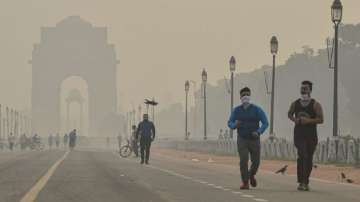Air quality in Delhi continues to be in the 'very poor' category, even after a slight improvement in the level of pollution was recorded. On Thursday, experts asserted the pollution situation was much better as compared to previous days, when the pollution had almost touched 'emergency' levels. A change in the wind direction -- from north westerly to north-north easterly -- was the reason behind the dip in pollution levels as it reduced the contribution of stubble burning significantly, according to government agencies and weather experts.
The city recorded an air quality index (AQI) of 315 at 9 am. The 24-hour average AQI was 344 on Wednesday and 476 on Tuesday.
Delhi witnessed six “severe” air days on the trot from November 4 to November 9, according to the Central Pollution Control Board (CPCB) data.
The AQI in neighbouring cities of Faridabad (306), Ghaziabad (336), Noida (291), Greater Noida (322), and Gurgaon (261), which fall in the National Capital Region (NCR), was also recorded in the “poor” and "very poor" categories.
Meanwhile, more than 870 COVID-19 deaths have been recorded in the last 15 days in the national capital, with experts attributing it to a sudden surge in cases, deteriorating air quality, laxity by people in adhering to safety norms, among other factors.
Coronavirus cases in Delhi have registered a sudden spike since October 28 when the daily infection tally breached the 5,000-mark for the first time and it crossed the 8,000-mark on Thursday, also for the first time.
From October 28-November 11, the city has recorded a staggering 90,572 cases and 872 fatalities with over 80 deaths daily in the last two days.
The city recorded 85 fatalities on Wednesday, which pushed the death toll to 7,228.
Also Read | Anti-smog guns installed in Noida Sector-6 to curb air pollution; more to come soon
Latest India News
